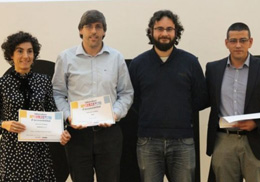
The University Research Institute on Robotics and Information and Communication Technologies (IRTC) of the University has been awarded in an ideas competition organised by “Las Naves”, an entity belonging to the City Council of Valencia. The award-winning project aims to develop a system that will allow blind people to map their environment through sounds. The idea is to develop a “sonar”, similar to the one used by bats, to facilitate them the movement in changing or unknown environments.
The prize belongs to the Accessibility Laboratory of this entity, whose objective is the improvement of the city of Valencia, by means of technological innovations, making it more inclusive and accessible to all citizens.
The awarded initiative is called 'Object Detection and Collision Prevention System for People with Reduced Visual Ability'. The system, proposed by the ARTEC researching group, with professor Marcos Fernández in the lead, suggests a solution that, through sounds warnings, allows blind people to have a perception of what surrounds them when they walk through an unknown area or an environment that is constantly changing.
The system consists of an application which will be developed for mobile phones that incorporate a "depth camera" and that the Valencia City Council will make available to the public through its Android Market account. For development, the Tango project belonging to Google will be used as a base. This project is the base to scan quickly and exactly the environment that surround us and to obtain 3D models of it. Once the 3D models have been obtained, always working with a minimum latency that provide operability to the system, and knowing at all times where the blind person is moving to, the system will be able to warn you if you have a lamppost or a pillar in front, or if someone has parked a motorcycle on the sidewalk.
During the presentation of the project before the jury, José Vicente Ribera, IRTIC researcher, has highlighted that it is a tool that can change “the daily life of many people who, because of their blindness, do not dare to go out alone or do not feel able to move themselves to the bathroom or to their own house.” Rivera added: "If we managed to make this system come out and work properly it could make the difference for thousands of people".
The award has been presented by the town councillor for innovation, Roberto Jaramillo. The projects presented by Vadeo 2.0 and Cuatrochenta have been also awarded. They are destined to a social network to improve accessibility and a tool to make EMT public transport more inclusive. The councillor for Social Services, Consol Castillo, has also attend the presentation before the jury and has opened the session.


















